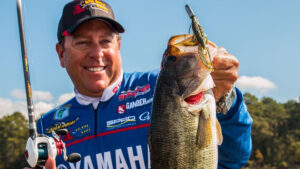Many of us have a love-hate relationship with grass fishing. On those special days when we’re able to figure out a productive pattern and put the pieces together, everyone else better watch out, because let’s face it—we’re hot to trot and not afraid to show it. But on those days when we can’t buy a bite and seemingly everything goes wrong, we curse the very thought of grass. Our bottom lip pokes out, we entertain the thought of pawning all of our gear and we take our proverbial ball and go home. We never liked fishing grass anyway.
Funny how things work, isn’t it?
Elite Series pro Dean Rojas has earned a reputation as being one of the best grass anglers in the world. He believes there are 10 things you can do to maximize your success and minimize common grass fishing frustrations.
Learn to identify the “good” grass
Regardless of the species of vegetation by which you’re surrounded, it’s important to understand the difference between “good” grass and “bad” grass. The good news is, it doesn’t take long to determine whether or not an area is worth fishing if you know what to look for.
“Any green grass is good grass,” Rojas said. “This means it’s alive and actively producing oxygen. Conversely, brown-colored grass is either dead or dying and as it decays, it robs the surrounding water of precious oxygen. It doesn’t matter where I’m fishing; I made a concerted effort to find the greenest grass I possibly can. It attracts life and makes things happen.”
It’s similar to ordering a salad at your favorite restaurant. When the waiter brings you a bowl full of crisp, bright-green colored leaves, it’s time to dig in and stuff your face. When you’re met with a pile of wilted, brown lettuce that’s as limp as a wet dish rag, however, your appetite is gone.
If you’re able to rip your bait or lure from the grass without noticing any nasty slime or moss clinging to it, you’re in business. If consecutive casts yield grass that looks similar to that disgusting restaurant salad, it may be time to move somewhere else.
Don’t skimp when it comes to your line
Despite braid’s rising popularity in the bass fishing community, some old-school anglers haven’t necessarily embraced its use yet. To each his own, but a resistance to change may come at a steep price in terms of fish catches and frustration.
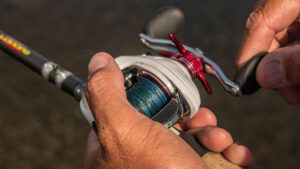
“Braided line is an enormous component to grass fishing,” Rojas said. “You cannot go wrong with it in this situation. You can fish more than a dozen techniques with 50 or 60-pound Sunline FX2 Braided Line. Monofilament and fluorocarbon are both smooth; they bog down in the grass and make things irritating. Braided line is much more textured and when you rip it, it acts like a chainsaw, more or less. It cuts through the grass and allows for a clean presentation.”
Also worth noting is the lack of stretch in braided line. When you set the hook on a big bass, the energy of your hookset is transferred directly to the fish which results in an excellent hookup ratio in thick vegetation.
Swim your soft plastics periodically
It’s tempting to get lulled into “robot mode” when you’re fishing soft plastics—especially when the action is slow. Pitch, let it sink, hop it a few times and repeat. This is the technique we’ve been taught since we can rememeber, but mixing it up and swimming your soft plastics can result in extra bites throughout the day.
“When I fish the edges of grass, I’ll rig my Big Bite Baits Fighting Frog with a 4/0 Gamakatsu SuperLine Offset EWG Hook, a 3/4-ounce tungsten weight and a punch skirt,” Rojas said. “I’ll flip it into little pockets and potential ambush points, but I’ll also swim it back to the boat and in front of the grass. The added punch skirt is an excellent imitation of a bluegill or fleeing crawfish and it’s a great way to get reaction strikes from otherwise lethargic bass. I’ve caught thousands of bass doing this.”
Never give up on Kermit
We’re all well aware of Rojas’ frog fishing prowess. But he doesn’t do it for his health. It catches giant bass and he’s a staunch believer in its nearly year-round effectiveness. If the water temperature is between 57 and 90 degrees, he has his collection of SPRO frogs ready for battle.
“You’ll know within the first 15 minutes whether or not they’re eating a frog,” Rojas said. “It doesn’t take long for ‘em to show themselves. But even if you don’t get any blow-ups initially, don’t put it away. I can’t stress that enough. By all means, pick up a swim jig, a punching rod or a flipping rod, but don’t give up on the frog.”
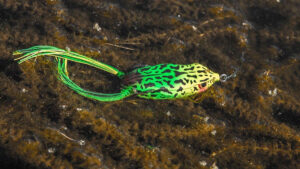
Why’s he so adamant about this frog thing? It’s simple—it’s all about timing. Bass rarely do the same thing throughout an entire day. They move, their attitudes change and small feeding windows continuously open and close. It may not last long, but when they start chewing on Kermit, it’s game on.
“They might only commit to that thing for a half-hour, but you’ll load the boat in a hurry when they fire,” Rojas said. “So pick it up and throw it periodically. If you hit it right, you’ll be grinning ear-to-ear.
Erase the grass in your mind
Fishing a grass-filled lake can almost cause a sensory overload for anglers. There’s so much of it and it all looks sexy. But Rojas tries not to get too carried away by the presence of vegetation. There are a lot of additional factors to consider.
To combat this common issue, he recommends “erasing” the grass with your mind. In other words, focus on the contour of the lake bottom. The drops, channel swings and the seasonal location of the fish all play a big role in his strategy.
“Try not to let the grass get in your head,” Rojas said. “If you try to fish it all, you’ll lose track of time before you know it. I’m looking for obvious things at first such as points, secondary points, short pockets and channel swings. These are all natural travel routes and stopping points for bass and once I take the time of year into consideration, I’ll have a solid idea of where I need to focus.”
Lay the wood to ‘em
We all have that “one” fishing buddy who darn-near falls out of the boat with each hookset—he looks more like an heavyweight MMA fighter than an angler when he gets a bite. It’ll scare the daylights out of you if you’re not prepared for it. Although we like to lightheartedly make fun of this guy, Mr. MMA might be tailor-made for grass fishing.
“Your hooksets need to be very, very aggressive,” Rojas said. “Give ‘em everything you got. You’re basically in that fish’s bedroom. You’re in their house. If someone were to try to take you from your house, you’d fight like crazy and know every potential way to avoid the threat. Bass are the same way. They have all the advantages and know exactly where to go in order to break you off.
You heard it from the man himself. Now you have every right to take out your frustrations on your hooksets. Make sure you tell your fishing buddy, too.
When grass mixes, bass bite
Professional anglers have been taking advantage of “mixed” grass for decades and for good reason—big bass are drawn to these areas. Whenever you see two different types of grass converge in one area, you should always be prepared for a bite. Essentially, it’s an irregularity to which a bass can relate.
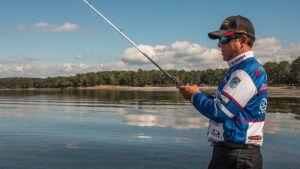
“This can be a really big deal,” Rojas said. “Bass are extremely attracted to anything that’s out of the ordinary. It’s an ideal ambush point in their minds. For instance, if you’re fishing a mat of Hydrilla and you see one or two random tule stalks sticking out of it, you’re going to get a bite. It doesn’t have to be much. Just a tiny area can produce an absolute giant.”
Although it seems as if these small irregularities may be difficult to locate, you’ll get the hang of it quickly. Once you get a few bites using this strategy, you’ll soon start finding similar areas throughout the entire lake.
Use your eyes, ears and… nose?
Being aware of your surroundings is always important, whether you’re fishing grass, docks, laydowns or stump flats. An observant outdoorsman is a good outdoorsman. But there are a few specific things you to consider whenever you’re surrounded by vegetation. The ability to detect these environmental cues is what separates a good grass angler from a great grass angler.
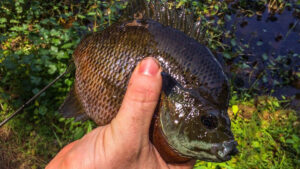
“Your ears can be your best friend when you’re dissecting grass,” Rojas said. “Any ‘popping’ or ‘flickering’ noises are likely indicative of nearby bluegill and shad activity. Not only does this give you confidence that bass are nearby, but it can also lead to important color and profile changes. Of course, it’s also important to use your eyes. Grass bass aren’t always stealthy—they’ll rub and bump into tules and you can see them traveling to the grass before they know you’re there.”
Be careful not to discount the importance of smell, too. If an area smells “fishy” to the human nose above the water, imagine what a bass smells underwater. You might be smelling a shallow school of shad, bluegill beds or shallow-feeding crappie—all of which are filet mignons of the bass world.
Identify depth changes
It’s easy to get tunnel vision while you’re fishing a long stretch of grass. If we’re honest with each other, it can even become a bit monotonous at times. Make certain, however, that you pay close attention to depth. Whether you’re using a Lowrance unit like Rojas or poking a rod tip in the water, it’s worth playing close attention to.
We hear it all the time—the biggest bass in a lake love deep water. It gives them a sense of security and an opportunity to rest between feeding periods, but it also acts as major migratory routes throughout the year. If you’re able to find grass with adjacent deep water, you’re in business.
“If you’re fishing a grass line and the depth drops from two to four feet, it’s certainly worth noting,” Rojas said. “Like we discussed earlier, even if it’s not a major travel route, it’s something different. That’s always a good thing in bass fishing. The bass can use these depth changes for ambush points, too. They can sit in a little ditch near a grass line and pounce on unsuspecting pray that passes above them.”
